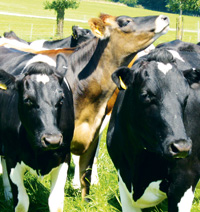Weight gain during first six months affects fertility

Correct bull choice for maiden heifers can reduce the chances of a hard calving. But while the traditional Angus or Hereford stock bull leads to lighter calf birthweights, it doesn’t speed up genetic gain. On the other hand, finding an easy-calving Holstein sire isn’t easy when different indices make comparisons between countries complicated.
While calving problems in heifers tend to be the result of either calf size or pelvic size, the latter can be readily influenced by management. That’s why growing heifers to meet mating and calving targets, as well as considering management at calving, are important. However, calf birth weights are also influenced by sex and breed, which means genetic influence can’t be ignored.
This is particularly true when US research has shown the odds of dystocia increase by 6% for every 0.45kg increase in birthweight for Holsteins. Furthermore, a study of 7380 calvings among Holstein dams showed 51.2% of calves born to first-calf heifers required assistance during calving.
But with only 38% of US herds having a system in place for scoring calving difficulties, researchers believe dystocia could be underestimated. In Britain, where the incidence is a more conservative 30%, a large proportion of cases are thought to be due to over-large calves and, therefore, avoidable.
What is clear is that the effects of dystocia in heifers are far reaching. In addition to a huge financial impact on milk production, heifer fertility suffers. And calves born after a difficult calving are more likely to die or get sick.
Heifer specialist Sam Leadley from Attica Vets, New York, cites a study at Colorado State University which grouped calves, from 6684 calvings, according to assistance given at calving. Group one had no assistance; Group two had one person helping (not mechanical); Group three had two or more people and/or mechanical/surgical intervention.
“Higher death rates were associated with higher assistance scores. In calves less than 48 hours old, Group three calves had 36% mortality. But this effect continued up to 120 days of age, when Group three calves had a death rate of 14.6% compared with Group one at just 8%. Not only that, but Group three calves had 17% more scour treatments and 56% more respiratory infections than Group one,” says Dr Leadley.
Where maiden heifers are kept away from home, the most practical solution may be to use a stock bull of a smaller breed such as an Angus or Hereford. A dairy stock bull won’t have been tested for calving ease, warns DairyCo’s Marco Winters. However, if heifers can be managed with suitable handling facilities, they can be inseminated with dairy semen.
Mr Winters suggests sexed semen to produce a smaller heifer calf – therefore increasing the chance of an easy calving – or picking calving ease sires, a task that will be simpler when the August proof run launches a single international calving ease index for Holsteins. “We hope to include calving ease proofs which will allow farmers to choose all Holstein bulls regardless of country of origin on one scale. We also hope to offer proofs for maternal calving ease based on how good the dam’s genetics are,” he says.
Another option is to switch to a Jersey sire for maiden heifers. This produces a small-framed light calf, an easier calving – and a valuable dairy crossbred. Pembrokeshire farmer Chris James thinks there is a ready market due to the current high demand for crossbreds.
Having crossbred for 10 years, Mr James now uses a Jersey, such as NZ Burnhart Magnet, on maiden heifers. “We use a Jersey for ease of calving and to get heifers milking in the herd and back in-calf quicker. Because the breed is finer boned, they produce a smaller calf – about 10kg lighter. As they are easy calving, we just select the highest index Jersey,” he says.
Mr James rarely has to calve a heifer and any heifers needing help tend to have a bad presentation rather than a problem with calf size. Before, when the sire was of Angus, Hereford or Limousin origin, he would assist up to one in three heifers. And with 450 heifers a year block-calving into his 1100-cow business, trouble-free births certainly take the pressure off calving such large numbers.
